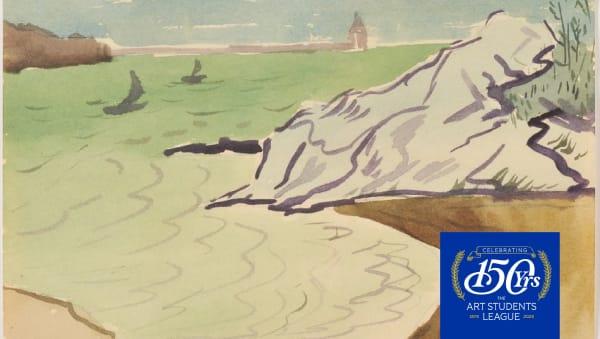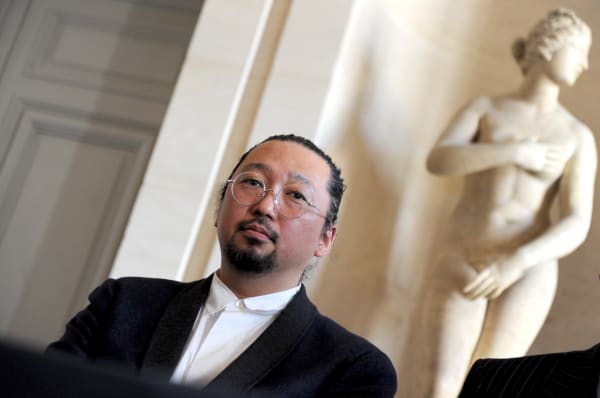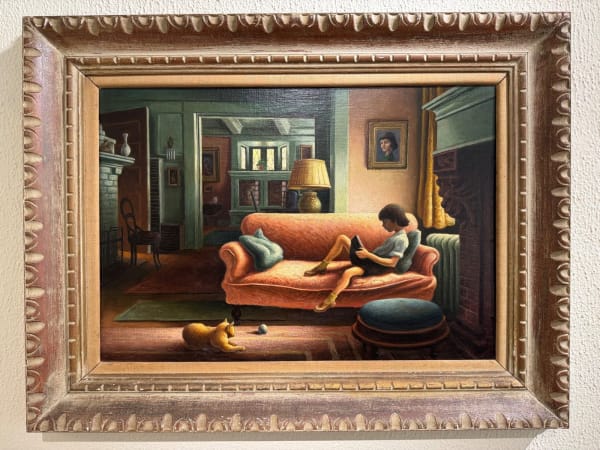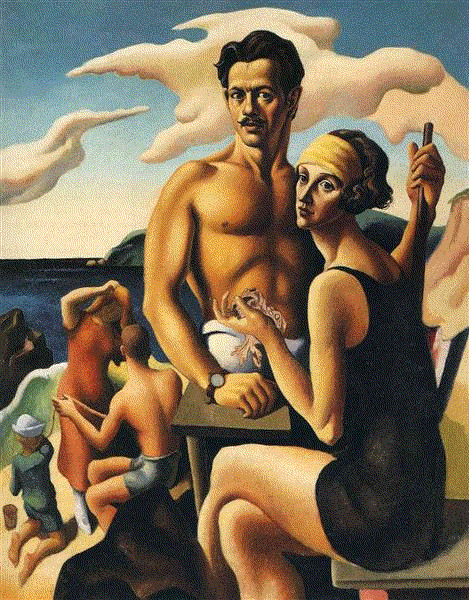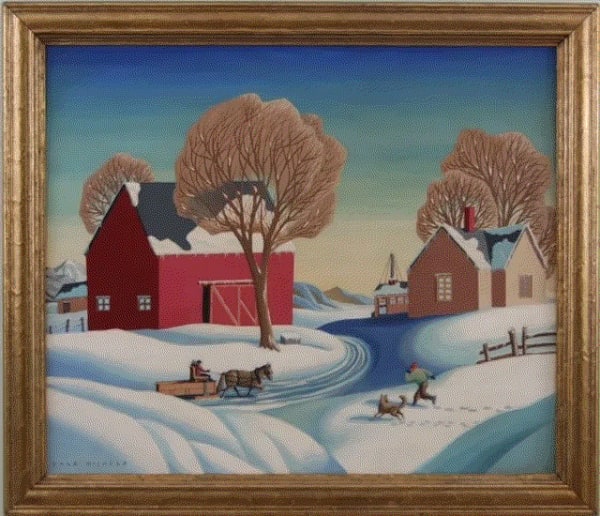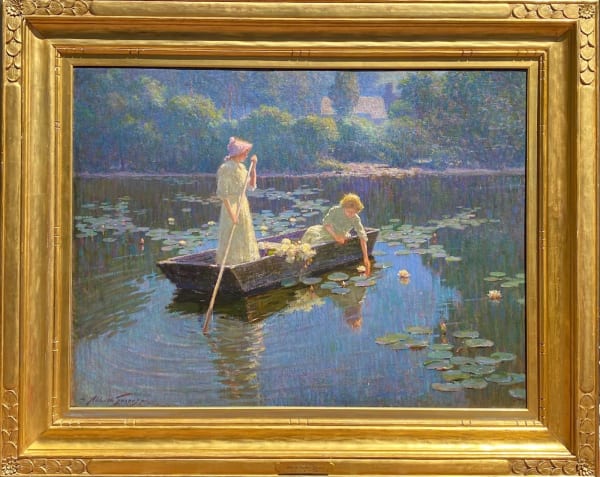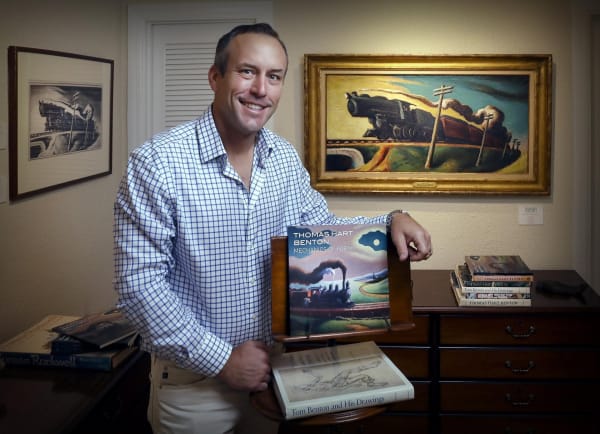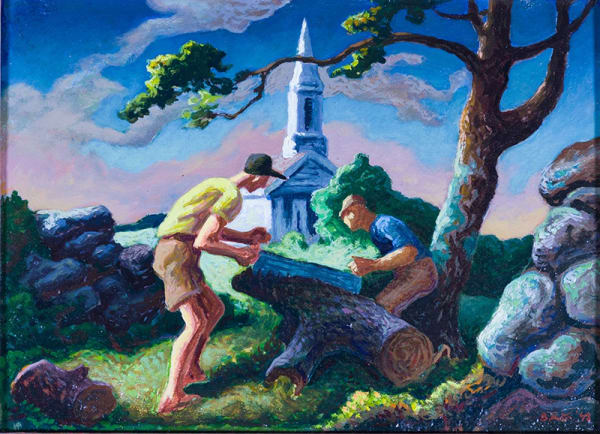Thomas Hart Benton
Thomas Hart Benton (1889-1975) chronicled the beauty, joys and sorrows of everyday life in America, until the day he died.
Early Life
Benton was born in 1889 in Neosho, Missouri, the oldest of four children. He spent much of his childhood and adolescence in Washington, D.C., where his lawyer father, Maecenas Eason Benton, served as a Democratic member of Congress from 1897 to 1905. Hoping to groom him for a political career, Benton's father sent him to Western Military Academy. After nearly two years at the academy, Benton convinced his mother to support him through two years at the Art Institute of Chicago, followed by two more years at the Academie Julian in Paris.
Education and Career
Benton returned to the States in 1912. He moved to New York where, with the continued financial support of his mother, he painted. One of his first jobs was painting sets for silent movies, which were being produced in Fort Lee, New Jersey. Benton credits this experience with giving him the skills he needed to produce his large scale murals.
When World War I broke out, Benton joined the Navy. He was stationed in Norfolk, Virginia, where he was assigned to draw the camouflaged ships that sailed into the harbor. The drawings were done to enable identification of each ship, in the event that it was lost in battle. The work was perfectly suited for Benton, who had enjoyed drawing trains and boats when he was a child.
Benton credits being a "camofleur" as having a profound impact on the course of his career.
"When I came out of the Navy after the First World War," he said, "I made up my mind that I wasn't going to be just a studio painter, a pattern maker in the fashion then dominating the art world-as it still does. I began to think of returning to the painting of subjects, subjects with meanings, which people in general might be interested in."
While he worked on his own original style that would become known as "Regionalism," Benton also taught, first at a city supported school and then at The Art Students League from 1926 - 1935. One of his students was a young Jackson Pollock, who looked upon Benton, not just as a mentor, but as father figure.
In 1930, Benton was commissioned to paint a mural for the New School for Social Research. The America Today mural, now at the Met, was followed by many more commissions that catapulted his career. Jackson Pollock was one of the models Benton used for America Today.
The Regionalist Movement took hold in the 1930s, during the Great Depression. The Regionalist painters, like Benton, Grant Wood and John Steuart Curry, depicted images that were reassuring and often comforting during a time of uncertainty in America. Time Magazine called Benton, "…the most virile of U.S. painters of the U.S. Scene" and put his self portrait on the cover of a 1934 issue that included a story about, "The Birth of Regionalism."
Marriage and Family
In 1922, Benton married Rita Piacenza, a former student who had emigrated from Italy. The couple had two children. Their son, Thomas, nicknamed T.P., was an accomplished musician. He spent time as the first flutist with the Orlando Symphony Orchestra. Benton played harmonica and, in 1942, they released a recording on Decca records called, Saturday Night at Tom Benton's. Accompanied by the American Chamber Music Group, T.P. played flute and Benton played harmonica.
Daughter, Jesse, was born in 1939. She married Mel Lyman, a musician and controversial founder of the Fort Hill Community in Boston. The Bentons were married for nearly fifty-three years. Thomas died in 1975, at age 85, while completing a mural for the Country Music Hall of Fame in Nashville. Rita died about eleven weeks later.
Later Life and Legacy
In 1935, Benton left New York and moved back to Missouri, where he taught at the Kansas City Art Institute. Benton's outspoken criticism of modern art, art critics and politically confusing rants, kept him out of step and often alienated from people in the political and art scenes. His talent, however, was enough to make him a sought-after artist, who has left behind some of the most spectacular murals, paintings and prints of American culture ever created.
Benton, whose paintings and murals contain high drama, was sought out by Hollywood producers to create paintings and posters for films. Twentieth Century Fox commissioned Benton to create lithographs for the film of John Steinbeck's Grapes of Wrath. Benton was always true to his own vision, which was to hold a mirror up to, and record, daily life in America.
Benton's work can be found at the Met, the Smithsonian, The Truman Library and many other museums and galleries across the U.S. He was elected to the National Academy of Design, has illustrated many books, wrote (and twice appended) his autobiography and is the subject of Thomas Hart Benton, a documentary by Ken Burns.
Send me more information on Thomas Hart Benton
-

The Art Students League Celebrates 150 Years
Showcased works by Milton Avery, Adolph Gottlieb and other Art Students League Alumni June 20, 2025The Art Students League of New York is celebrating its 150th anniversary with an exhibition of works by many of its most talented artists. The...Read more -

Takashi Murakami at Dodger Stadium
Thomas Hart Benton at the Country Music Hall of Fame May 8, 2025Takashi Murakami (b.1962) threw the first pitch at Dodgers Stadium in LA last week to celebrate Japanese Heritage Night. Three of the Dodgers’ players are...Read more -

Recent Acquisition at Surovek Gallery: Jessie on the Couch by Thomas Hart Benton
April 24, 2025I have a sort of inner conviction that for all the possible limitations of my mind and the disturbing effects of my processes, for all...Read more -

Thomas Hart Benton and Loie Hollowell at the Hirshhorn
November 14, 2024I have a sort of inner conviction that for all the possible limitations of my mind and the disturbing effects of my processes, for all...Read more -

Great Artists, Great Teachers: Hans Hofmann, Thomas Hart Benton and Nicolas Carone
August 23, 2024A teacher affects eternity; he can never tell where his influence stops. – Hans Hofmann As an artist and a teacher, Hans Hofmann (1880-1966) had...Read more -

Milton Avery and the Federation of Modern Painters and Sculptors
August 14, 2024“ I like to seize the one sharp instant in Nature, to imprison it by means of ordered shapes and space relationships. To this end...Read more -

Homes for the Holidays
December 21, 2023This is a time of year often brings up feelings of nostalgia for the places that inspire tender and sentimental memories. The works of Dale...Read more -

Recent Acquisitions at Surovek Gallery
Works by Abbott Fuller Graves, Thomas Hart Benton, Milton Avery, Sam Francis, Orville Bulman, Kenneth Noland and Mel Bochner September 29, 2023We are pleased to announce our recent acquisitions of works by some of America’s finest artists, representing a wide range of styles and techniques. The...Read more -

The Changing Landscape of Landscape Paintings
May 4, 2023The New York Historical Society is currently hosting an exhibit that explores the impact of social and cultural change on the environment through art. Many of the works displayed have been made by artists of the Hudson River School.Read more -

Recent Acquisitions: Works by Andrew Wyeth, Thomas Hart Benton and Martin Lewis
May 19, 2021Recent acquisitions at Surovek Gallery include the works of some of the greatest American (and one European) artists who have contributed to the breadth and...Read more -

The Art of Snow and Fog
February 2, 2021This has been a harsh winter in many parts of the country. It’s a natural human reaction to want to hunker down inside a warm,...Read more -

Art at the Post Office
August 19, 2020There’s been a lot of news this week about saving the United States Post Office, a service that many of us take for granted. The...Read more -

Remembering Our Soldiers
May 29, 2020This year Memorial Day was celebrated quietly, without much fanfare and without parades. When we looked at some of the paintings of soldiers in our...Read more -

Palm Beach Art Galleries
June 12, 2019In 1879, New York industrialist and oil tycoon, Henry Flagler, visited Florida and envisioned the creation of an American Riviera. It was the right time,...Read more -

Thomas Hart Benton: Ships and Stories
May 28, 2019Thomas Hart Benton’s work had a profound effect on American art. Born in 1889, he lived through World War l, World War ll and the...Read more -

Surovek Gallery Show Exposes Benton’s Modernist Roots
March 5, 2019This article by Jan Sjostrom originally posted on palmbeachdailynews.com In Thomas Hart Benton ’s painting “Going West,” a train pulled by a coal-black engine hurtles...Read more -

Thomas Hart Benton: Mechanics of Form
February 12, 2019The Surovek Gallery in Palm Beach, Florida, is presenting a new exhibition of around 65 works by Thomas Hart Benton (1889-1975), the famed Regionalist painter...Read more -

Backwoods Aristocrat Thomas Hart Benton
July 13, 2018The American public could easily relate to the down-home, heartland feel of the work of Thomas Hart Benton. His Regionalist paintings and lithographs depicted the...Read more -

Thomas Hart Benton: Mystery Solved
April 18, 2018Thomas Hart Benton was one of the most popular, interesting and controversial artists of twentieth century America. He was born in Missouri in 1889. His...Read more -

The Power and Passion of Thomas Hart Benton Prints
March 17, 2017Looking at America He was larger than life, a brawler and a drinker, but Thomas Hart Benton’s prints, created during the Great Depression, spoke of...Read more




